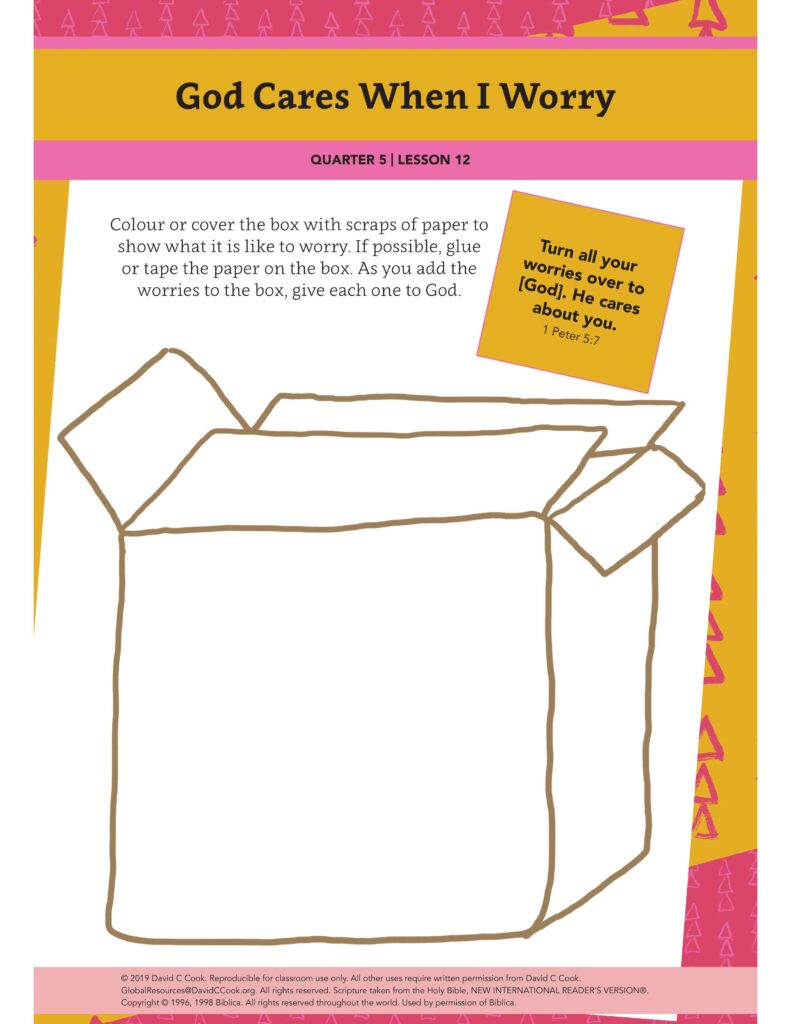During the lesson, the information for you to know is written in regular type, and what we suggest speaking or reading aloud to children is in bold. All resources for this lesson, including the Teacher Guide, Student Page, Family Connection Card, and other resources can be downloaded in a ZIP file by clicking on the following link:
In some lessons you will find "resource articles." These are articles written by experts from around the world to help equip you for your work with children and adolescents. Share them with parents or guardians if you consider it appropriate.
The box will be used in the Connecting activity. It will be a pretend “worry machine.” It will need to have 2 open sides so you can pass an object through it. If you do not have a box available, use another object that you can pass an object through.
Turn all your worries over to [God]. He cares about you.
1 Peter 5:7
Life is not always easy. In fact, for some of us, life is rarely easy. Physical and mental pain can come to us from many different places. The struggles we face test our hearts, minds, bodies, and souls on a regular basis. As a result, worry can easily creep into our lives and take hold of us.
That is why this verse is so important. As a follower of Christ, you have someone you can turn to for help when you worry. God cares about you! He will take your worries and give you hope. When you trust in God’s love and care for you, you can put aside your worries and find hope. God is here, right now, and He not only listens to your worries but also takes them away and covers you with His peace. Life still may not be easy, but you can be greatly encouraged when you turn to God. He will give you hope!
Encourage families to talk to their children about what it means to worry. Ask the children to share what they have learned about how to deal with their worries.
Teacher Tip: If possible, email or text the Family Connection Card to the families of your students.
As you greet your children, ask them to think of some things that might cause people to worry. Have them find partners and briefly share their thoughts.
I need all of you to help me with something. Let’s pretend that this box is a machine. This machine will make things. Some machines help to make clothes, some make car parts, and others make toys. Let’s pretend that our machine makes worries. Yes, you heard me correctly, this is a “worry machine.” We all worry about things in our lives. When we have thoughts that make us feel concerned, anxious, or troubled, we are worried.
Allow 3–4 children to respond. Children may worry about many different things.
There are many different things that can cause us to worry. Take a moment to think about 1 thing that you worry about. This can be something that you worry about a lot or something that you worry about just a little bit.
Pause for 30 seconds for children to think of worries they have.
As you think of something you worry about, think about why that thought makes you worry. Things such as not having enough food to eat, seeing someone hurt another person, and losing someone we love can cause us to worry.
Allow the children to think a little longer as you place a pile of objects next to the “worry machine.” In the following activity, the children will each use 1 object to create a worry. Have the children form a line starting at the “machine.”
Let’s pretend that our machine will make a worry for each person in the class. Each of you will take an object from this pile and place it in 1 side of the machine. It will come out the other side as the worry you just thought about. You will hold on to your worry for the rest of the lesson.
Guide 1 child at a time to take an object and place it in 1 side of the “machine.” Then, you will pass the object through to the other side of the “machine.” The child will then take the object back to his seat.
Optional: If you are using Student Pages, provide the children with scraps of coloured paper or other colourful materials. If available, give each child a small amount of glue or tape. Allow them 3 minutes to place the materials on their pages.

We all have worries. Today, we will learn about the things that can help us when we worry.
The last time we met, we learned about a man named Job. Do you remember what happened to Job in his true story from the Bible? He lost almost everything! Right after Job lost his children, animals, and the things he owned, he spoke about what had happened. Listen again to what he said.
Read this verse directly from your Bible.
What I was afraid of has come on me. What I worried about has happened to me.
Job 3:25
Job was worried because he did not understand why so many bad things had happened to him. He might have been afraid that more bad things would happen to him. Job worried, and worried, and worried some more as he thought about what had happened to him.
When bad things happen to us, it can cause us to worry. When something really bad happens, it may feel like the worry will never go away. However, there are things you can do to help you worry less.
1. Give yourself time to think about the worry. This might sound like a strange way to worry less! When you allow yourself time to think about your worry, it can make you feel better. To do this, take a walk in a quiet place and think, write, or draw what you are worried about. When you give yourself time to think about your feelings, it can help you feel better. As I read a few questions that might help, think about the worry you identified at the beginning of class.
Pause for 30 seconds after each question to allow children to think about their worries.
2. Calm yourself down. Sometimes, worry can lead to panic. Panic is a sudden feeling of fear that takes over your thoughts and, sometimes, your actions. When our minds are worried, our bodies can respond in ways that are not healthy. Our hearts may beat faster, or we may start to shake. Breathing deeply and relaxing can keep our bodies working and help our minds to feel more peaceful. We learned about breathing deeply when we talked about anger. When you feel worried, breathing deeply can also help you. Let’s practice this. As I count to 3, you will breathe in slowly. You should take all 3 counts to finish breathing in. I will then count to 3 again as you breathe out slowly in the same way. Ready? Breathe in, 1, 2, 3. Breathe out, 1, 2, 3.
Guide the children in breathing deeply 2 more times.
Breathing deeply makes me feel much calmer. Do you feel calmer? Let’s talk about another way you can calm down and feel better when you are worried.
3. Remember how much God loves you! That is right, God cares when you are suffering. He cares when you are in trouble, and He wants you to come to Him when you are worried. God does not always take away our suffering, but He does give us hope.
Listen to what the Bible says:
Turn all your worries over to [God]. He cares about you.
1 Peter 5:7
Allow 2–3 children to respond.
When you pray to God, you can tell Him about the things you worry about. When you tell Him about your worries, you can let them go and not think about them anymore. In some situations, this is much more difficult to do than it is in others. Do not feel ashamed if you struggle to let go of your worries. God will help you!
4. Think about the good things in your life. The last time we met, we said that we can try to think of 5 things that are good in our lives. Hold up 1 hand with your fingers spread out. This is how many good things you should try to think of, but even if you can only think of 1, this can help you to stop worrying.
We can think of things around us that are good, such as safe places and kind people. We can think of things that have happened in our lives. Some examples include: God created us, we are able to gather together in this place, and we are learning about God’s love for us.
Give the children about 45 seconds to think of good things in their lives.
Wow! You all thought of many good things in your lives. Now let’s practice giving our worries to God by using what we have learned today.
Let’s play a game to help us give our worries to God. At the beginning of this lesson, each of you took a worry from the “worry machine.” I asked you to keep your worries for the rest of this lesson. Do you know what? Now it is time to get rid of your worries!
You learned about many ways of dealing with worry today.
Answers may include: I can give myself time to think about the worry. I can calm myself down. I can think of good things in my life. I can pray.
I can pray and ask God to take your worry away.
Take a moment to think about your worry. Think about what caused this worry. Think about why you are still worried about it. Now, use those thoughts to help you pray. As I pray out loud, you may pray silently.
Now, bring your objects and stand side by side next to me. God can take away your worries when you pray. To help you remember this, let’s throw away our worries! When I say, “Go,” throw your object as far as you can. Please make sure to throw it straight in front of you so that it does not hit anyone. Ready? Go!
God really does care about you when you worry. He cares so much that He will take your worries from you. Today’s memory verse talks about how much God cares for you.
Show the Memory Verse poster if you are using it.
My spirit, why are you so sad? Why are you so upset deep down inside me? Put your hope in God. Once again I will have reason to praise him. He is my Savior and my God.
Psalm 42:11

Read each of the following parts of the verse again as you show the children the motions for this verse. Then, repeat the motions with the children 3 times.
End class by saying this blessing, based on 1 Peter 5:7, over the children.
Blessing: May you choose to turn your worries over to God. May you find comfort in knowing He cares about you.
Lead the students in singing this quarter’s song, if possible.
Life on Life ©2020 David C Cook. Reproducible for home or classroom use only. All other uses require written permission from David C Cook [email protected]. All rights reserved.